Bachelor of Nursing: CHF Case Study, Nursing Interventions, Discharge
VerifiedAdded on 2023/01/17
|11
|3122
|67
Case Study
AI Summary
This case study analyzes the nursing care of a 70-year-old male patient, Mr. Smith, experiencing a CHF exacerbation. It utilizes the ABCDE framework to assess the patient's condition, including airway, breathing, circulation, disability, and exposure. The case study details nursing interventions for impaired gas exchange and excess fluid in the lungs, such as oxygen administration, breathing techniques, and endotracheal suction. It also covers interventions for fluid removal, including IV fluids, sodium intake limitations, and heparin lock devices. The assignment further outlines a comprehensive discharge plan, considering the patient's medical history, current issues, medications, diet, and follow-up care, with a focus on promoting optimal patient outcomes. The paper demonstrates an understanding of nursing care, interventions, and discharge planning for patients with CHF.
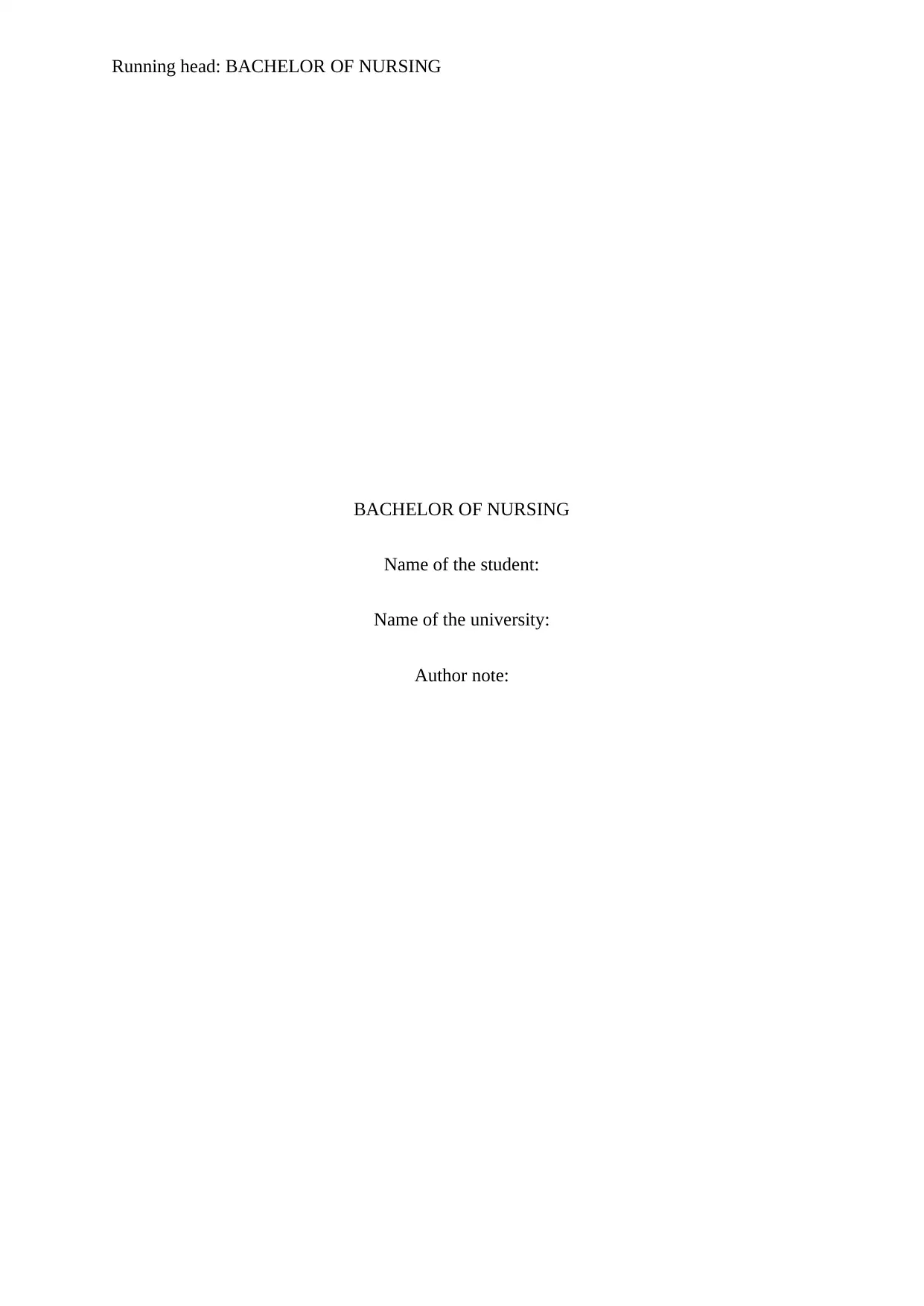
Running head: BACHELOR OF NURSING
BACHELOR OF NURSING
Name of the student:
Name of the university:
Author note:
BACHELOR OF NURSING
Name of the student:
Name of the university:
Author note:
Paraphrase This Document
Need a fresh take? Get an instant paraphrase of this document with our AI Paraphraser
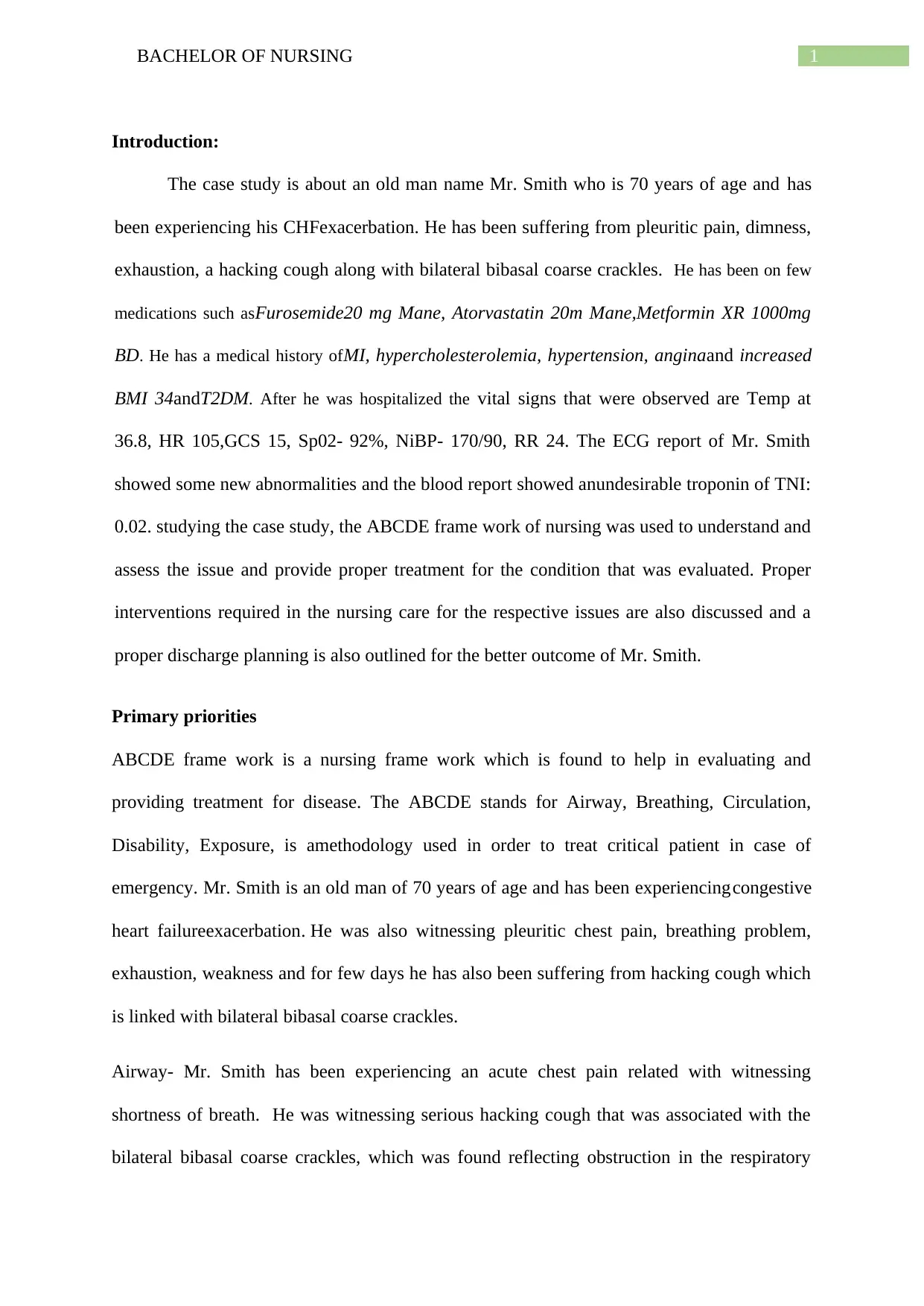
1BACHELOR OF NURSING
Introduction:
The case study is about an old man name Mr. Smith who is 70 years of age and has
been experiencing his CHFexacerbation. He has been suffering from pleuritic pain, dimness,
exhaustion, a hacking cough along with bilateral bibasal coarse crackles. He has been on few
medications such asFurosemide20 mg Mane, Atorvastatin 20m Mane,Metformin XR 1000mg
BD. He has a medical history ofMI, hypercholesterolemia, hypertension, anginaand increased
BMI 34andT2DM. After he was hospitalized the vital signs that were observed are Temp at
36.8, HR 105,GCS 15, Sp02- 92%, NiBP- 170/90, RR 24. The ECG report of Mr. Smith
showed some new abnormalities and the blood report showed anundesirable troponin of TNI:
0.02. studying the case study, the ABCDE frame work of nursing was used to understand and
assess the issue and provide proper treatment for the condition that was evaluated. Proper
interventions required in the nursing care for the respective issues are also discussed and a
proper discharge planning is also outlined for the better outcome of Mr. Smith.
Primary priorities
ABCDE frame work is a nursing frame work which is found to help in evaluating and
providing treatment for disease. The ABCDE stands for Airway, Breathing, Circulation,
Disability, Exposure, is amethodology used in order to treat critical patient in case of
emergency. Mr. Smith is an old man of 70 years of age and has been experiencingcongestive
heart failureexacerbation. He was also witnessing pleuritic chest pain, breathing problem,
exhaustion, weakness and for few days he has also been suffering from hacking cough which
is linked with bilateral bibasal coarse crackles.
Airway- Mr. Smith has been experiencing an acute chest pain related with witnessing
shortness of breath. He was witnessing serious hacking cough that was associated with the
bilateral bibasal coarse crackles, which was found reflecting obstruction in the respiratory
Introduction:
The case study is about an old man name Mr. Smith who is 70 years of age and has
been experiencing his CHFexacerbation. He has been suffering from pleuritic pain, dimness,
exhaustion, a hacking cough along with bilateral bibasal coarse crackles. He has been on few
medications such asFurosemide20 mg Mane, Atorvastatin 20m Mane,Metformin XR 1000mg
BD. He has a medical history ofMI, hypercholesterolemia, hypertension, anginaand increased
BMI 34andT2DM. After he was hospitalized the vital signs that were observed are Temp at
36.8, HR 105,GCS 15, Sp02- 92%, NiBP- 170/90, RR 24. The ECG report of Mr. Smith
showed some new abnormalities and the blood report showed anundesirable troponin of TNI:
0.02. studying the case study, the ABCDE frame work of nursing was used to understand and
assess the issue and provide proper treatment for the condition that was evaluated. Proper
interventions required in the nursing care for the respective issues are also discussed and a
proper discharge planning is also outlined for the better outcome of Mr. Smith.
Primary priorities
ABCDE frame work is a nursing frame work which is found to help in evaluating and
providing treatment for disease. The ABCDE stands for Airway, Breathing, Circulation,
Disability, Exposure, is amethodology used in order to treat critical patient in case of
emergency. Mr. Smith is an old man of 70 years of age and has been experiencingcongestive
heart failureexacerbation. He was also witnessing pleuritic chest pain, breathing problem,
exhaustion, weakness and for few days he has also been suffering from hacking cough which
is linked with bilateral bibasal coarse crackles.
Airway- Mr. Smith has been experiencing an acute chest pain related with witnessing
shortness of breath. He was witnessing serious hacking cough that was associated with the
bilateral bibasal coarse crackles, which was found reflecting obstruction in the respiratory

2BACHELOR OF NURSING
passage of Mr. Smith. The adequate amount of oxygen was supplied into the body by oxygen
mask to Mr. Smith to relive him from pain and medication furosemide was administered for
the CHF issue (Ohad et al. 2018).
Breathing- Mr. Smith was witnessing serious problem of shortness of breath. The respiratory
rate of Mr. Smith was 24beats/minutes where is normal 12-20 beats/minutes. Sp02 of Mr.
Smith was 92% but normal sp02 level should be 94%-100% and between 88%to 94% in case
of patient suffering from chest pain and respiratory complications. Oxygen therapy was
continuously provided to Mr. Smith to treat the issue of shortness of breath.
Circulation- Mr. Smith has been suffering from various kind of disorder such as,
hypercholesteremia, where the quantity of cholesterol increases in a person’s blood. He has a
medical history of hypertension, a condition where the blood pressure increases; NiBP of Mr.
Smith was 170/90, the normal range should be 120/80. The blood flow of Mr. Smith was
decreased which a reason behind the occurrence of myocardial infection causing chest pain
was also known as Angina. Negative troponin was examined in the blood (0.02). Morphine
and paracetamol was provided to Mr. Smith to reduce his pain and Atorvastatin for
hypercholesteremia (Li 2015).
Disability- After calculating the blood glucose level it was observed that Mr. Smith was
suffering from type 2 Diabetes Mellitus. BMI of Mr. Smith was 34, greater than the normal
level (18.5- 24.9), which indicated his obesity condition. Mr. Smith was facing fatigue and
weakness and he was administered with Metformin is provided for diabetes (Forslund et al.
2015).
Exposure- Mr. Smith was worried and anxious about the fact that which one is responsible
for acute MI. His heart rate, sp02, respiratory rate BGl, NiBP was monitored continuously.
passage of Mr. Smith. The adequate amount of oxygen was supplied into the body by oxygen
mask to Mr. Smith to relive him from pain and medication furosemide was administered for
the CHF issue (Ohad et al. 2018).
Breathing- Mr. Smith was witnessing serious problem of shortness of breath. The respiratory
rate of Mr. Smith was 24beats/minutes where is normal 12-20 beats/minutes. Sp02 of Mr.
Smith was 92% but normal sp02 level should be 94%-100% and between 88%to 94% in case
of patient suffering from chest pain and respiratory complications. Oxygen therapy was
continuously provided to Mr. Smith to treat the issue of shortness of breath.
Circulation- Mr. Smith has been suffering from various kind of disorder such as,
hypercholesteremia, where the quantity of cholesterol increases in a person’s blood. He has a
medical history of hypertension, a condition where the blood pressure increases; NiBP of Mr.
Smith was 170/90, the normal range should be 120/80. The blood flow of Mr. Smith was
decreased which a reason behind the occurrence of myocardial infection causing chest pain
was also known as Angina. Negative troponin was examined in the blood (0.02). Morphine
and paracetamol was provided to Mr. Smith to reduce his pain and Atorvastatin for
hypercholesteremia (Li 2015).
Disability- After calculating the blood glucose level it was observed that Mr. Smith was
suffering from type 2 Diabetes Mellitus. BMI of Mr. Smith was 34, greater than the normal
level (18.5- 24.9), which indicated his obesity condition. Mr. Smith was facing fatigue and
weakness and he was administered with Metformin is provided for diabetes (Forslund et al.
2015).
Exposure- Mr. Smith was worried and anxious about the fact that which one is responsible
for acute MI. His heart rate, sp02, respiratory rate BGl, NiBP was monitored continuously.
⊘ This is a preview!⊘
Do you want full access?
Subscribe today to unlock all pages.

Trusted by 1+ million students worldwide
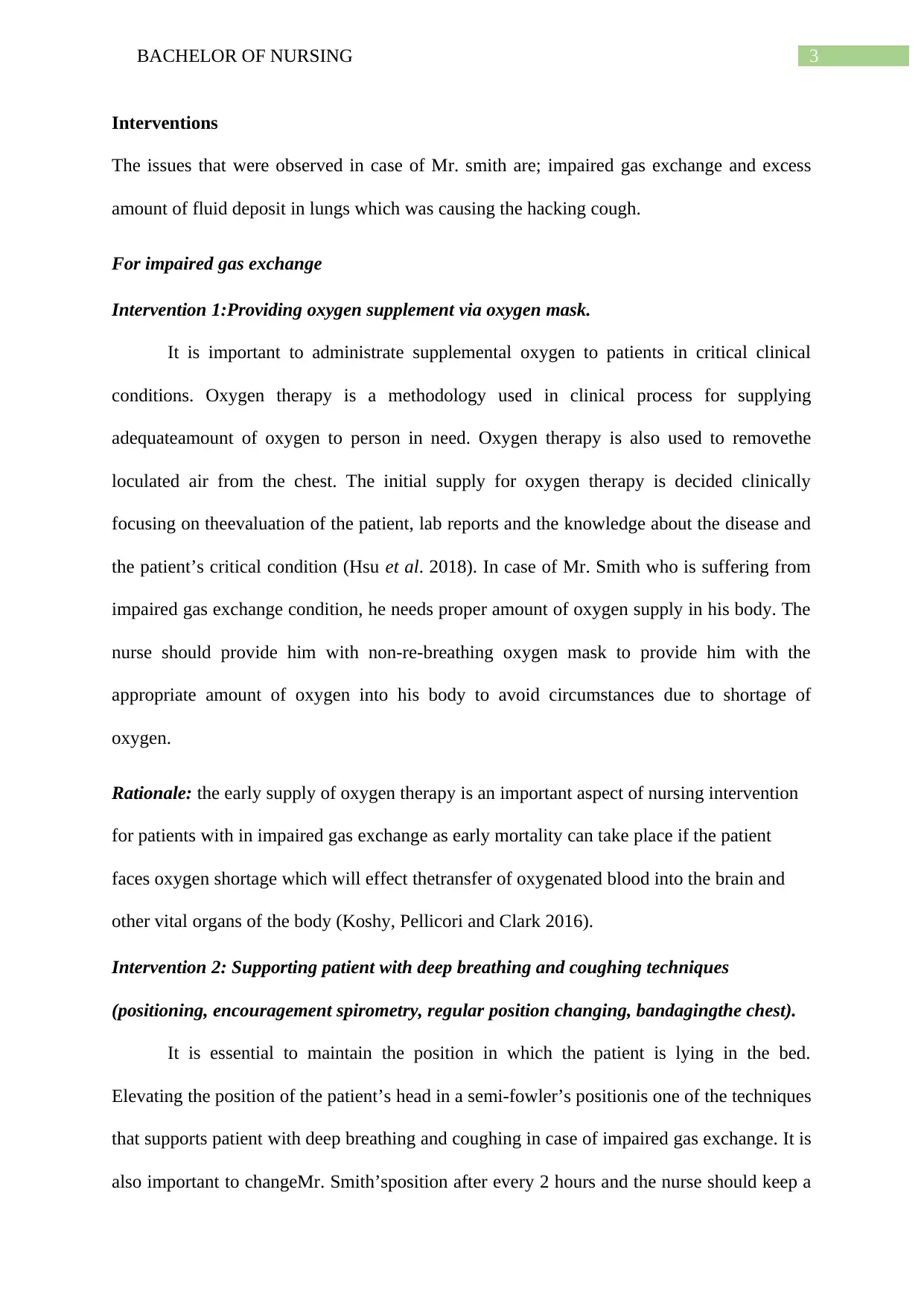
3BACHELOR OF NURSING
Interventions
The issues that were observed in case of Mr. smith are; impaired gas exchange and excess
amount of fluid deposit in lungs which was causing the hacking cough.
For impaired gas exchange
Intervention 1:Providing oxygen supplement via oxygen mask.
It is important to administrate supplemental oxygen to patients in critical clinical
conditions. Oxygen therapy is a methodology used in clinical process for supplying
adequateamount of oxygen to person in need. Oxygen therapy is also used to removethe
loculated air from the chest. The initial supply for oxygen therapy is decided clinically
focusing on theevaluation of the patient, lab reports and the knowledge about the disease and
the patient’s critical condition (Hsu et al. 2018). In case of Mr. Smith who is suffering from
impaired gas exchange condition, he needs proper amount of oxygen supply in his body. The
nurse should provide him with non-re-breathing oxygen mask to provide him with the
appropriate amount of oxygen into his body to avoid circumstances due to shortage of
oxygen.
Rationale: the early supply of oxygen therapy is an important aspect of nursing intervention
for patients with in impaired gas exchange as early mortality can take place if the patient
faces oxygen shortage which will effect thetransfer of oxygenated blood into the brain and
other vital organs of the body (Koshy, Pellicori and Clark 2016).
Intervention 2: Supporting patient with deep breathing and coughing techniques
(positioning, encouragement spirometry, regular position changing, bandagingthe chest).
It is essential to maintain the position in which the patient is lying in the bed.
Elevating the position of the patient’s head in a semi-fowler’s positionis one of the techniques
that supports patient with deep breathing and coughing in case of impaired gas exchange. It is
also important to changeMr. Smith’sposition after every 2 hours and the nurse should keep a
Interventions
The issues that were observed in case of Mr. smith are; impaired gas exchange and excess
amount of fluid deposit in lungs which was causing the hacking cough.
For impaired gas exchange
Intervention 1:Providing oxygen supplement via oxygen mask.
It is important to administrate supplemental oxygen to patients in critical clinical
conditions. Oxygen therapy is a methodology used in clinical process for supplying
adequateamount of oxygen to person in need. Oxygen therapy is also used to removethe
loculated air from the chest. The initial supply for oxygen therapy is decided clinically
focusing on theevaluation of the patient, lab reports and the knowledge about the disease and
the patient’s critical condition (Hsu et al. 2018). In case of Mr. Smith who is suffering from
impaired gas exchange condition, he needs proper amount of oxygen supply in his body. The
nurse should provide him with non-re-breathing oxygen mask to provide him with the
appropriate amount of oxygen into his body to avoid circumstances due to shortage of
oxygen.
Rationale: the early supply of oxygen therapy is an important aspect of nursing intervention
for patients with in impaired gas exchange as early mortality can take place if the patient
faces oxygen shortage which will effect thetransfer of oxygenated blood into the brain and
other vital organs of the body (Koshy, Pellicori and Clark 2016).
Intervention 2: Supporting patient with deep breathing and coughing techniques
(positioning, encouragement spirometry, regular position changing, bandagingthe chest).
It is essential to maintain the position in which the patient is lying in the bed.
Elevating the position of the patient’s head in a semi-fowler’s positionis one of the techniques
that supports patient with deep breathing and coughing in case of impaired gas exchange. It is
also important to changeMr. Smith’sposition after every 2 hours and the nurse should keep a
Paraphrase This Document
Need a fresh take? Get an instant paraphrase of this document with our AI Paraphraser

4BACHELOR OF NURSING
check on Mr. Smith in regular interval of time in order to avoid any movement or change in
the position. Bandaging the patient’s chest will help in reducing the chest pain as it restricts
the movement of the chest muscles and helps the patient in deep breathing and coughing
(Westerdahl 2015).
Rationale:the method is found to promote the alveolar enlargement and it also prevents
alveolar downfall. Bandaging the chest ishelpful in reducing pain and it enhancesthe ability
of the patient to breath better and cough without difficulty (Keszler and Claure 2019).
Intervention 3: Endotracheal suction
The endotracheal suction is a process which is performed using, sterilized,
atoxic,siliconized polyvinyl chloride French catheter of size 12 withanadjacentopening and a
bottom cavity, and with a pressure control valve. It is used to clear the respiratory tract of
patient who is not in a condition to clear the respiratory secretions (Schults et al. 2018). In
case of Mr. smith, it is important to clear his respiratory tract by removing the blockage by
the secretions so that he experiences a better breathing condition.The nurse needs to insert the
catheter through Mr. Smith’s nose or endotracheal tube. The nurse needs to be very gentle
with him while inserting the tube. After it is inserted, via suction remove the secretion and
clear the respiratory tract and now gently remove the catheter. If further suction is needed, let
the patient rest and recover from the stress of the suction for some times and then
proceed.Throughout the procedure, keep monitoring the oxygen levels and heart beat rate to
ensure that the patient is in a state to tolerate the process of suction. The suctioning process
should be maintained to 10 seconds.
check on Mr. Smith in regular interval of time in order to avoid any movement or change in
the position. Bandaging the patient’s chest will help in reducing the chest pain as it restricts
the movement of the chest muscles and helps the patient in deep breathing and coughing
(Westerdahl 2015).
Rationale:the method is found to promote the alveolar enlargement and it also prevents
alveolar downfall. Bandaging the chest ishelpful in reducing pain and it enhancesthe ability
of the patient to breath better and cough without difficulty (Keszler and Claure 2019).
Intervention 3: Endotracheal suction
The endotracheal suction is a process which is performed using, sterilized,
atoxic,siliconized polyvinyl chloride French catheter of size 12 withanadjacentopening and a
bottom cavity, and with a pressure control valve. It is used to clear the respiratory tract of
patient who is not in a condition to clear the respiratory secretions (Schults et al. 2018). In
case of Mr. smith, it is important to clear his respiratory tract by removing the blockage by
the secretions so that he experiences a better breathing condition.The nurse needs to insert the
catheter through Mr. Smith’s nose or endotracheal tube. The nurse needs to be very gentle
with him while inserting the tube. After it is inserted, via suction remove the secretion and
clear the respiratory tract and now gently remove the catheter. If further suction is needed, let
the patient rest and recover from the stress of the suction for some times and then
proceed.Throughout the procedure, keep monitoring the oxygen levels and heart beat rate to
ensure that the patient is in a state to tolerate the process of suction. The suctioning process
should be maintained to 10 seconds.
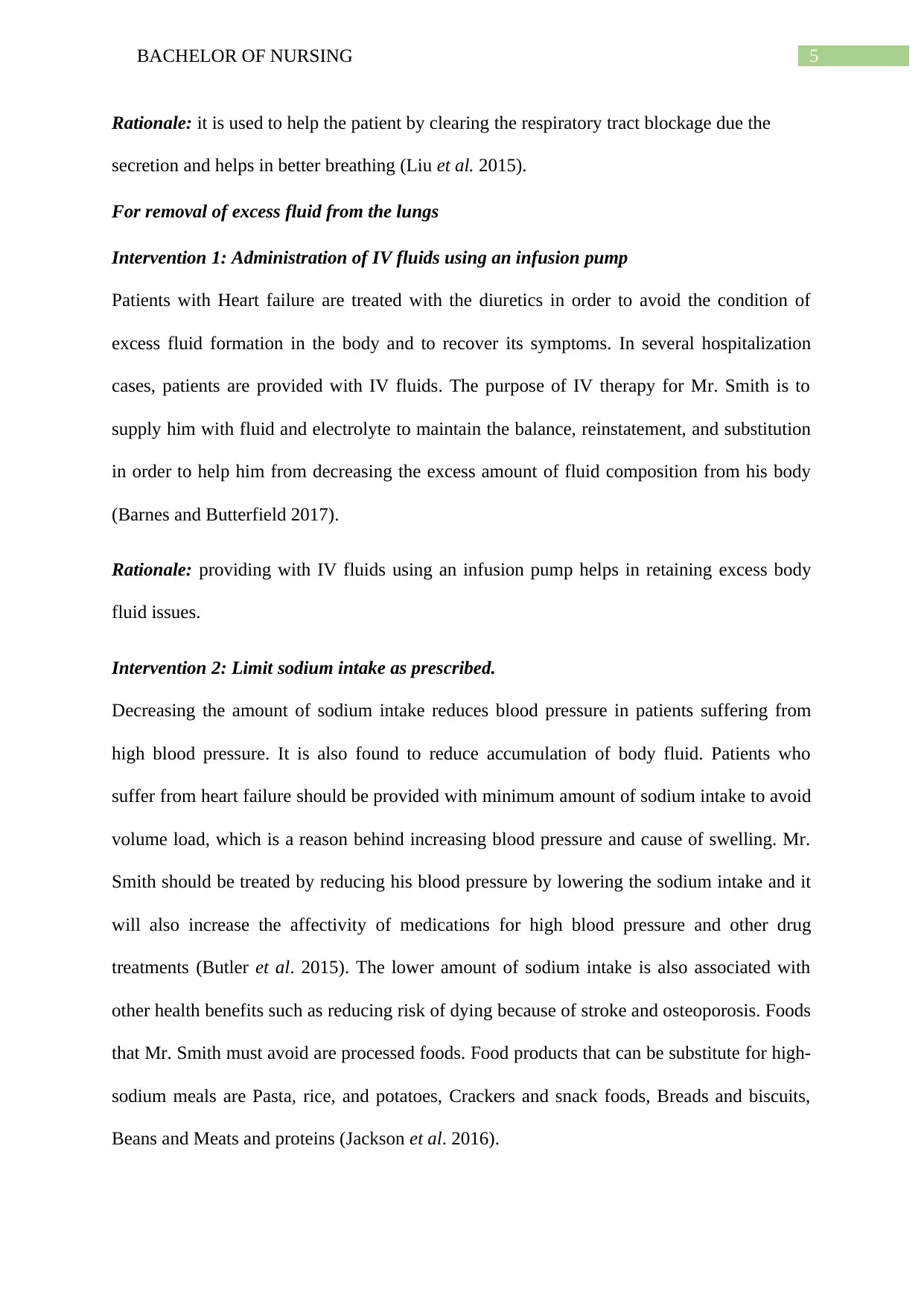
5BACHELOR OF NURSING
Rationale: it is used to help the patient by clearing the respiratory tract blockage due the
secretion and helps in better breathing (Liu et al. 2015).
For removal of excess fluid from the lungs
Intervention 1: Administration of IV fluids using an infusion pump
Patients with Heart failure are treated with the diuretics in order to avoid the condition of
excess fluid formation in the body and to recover its symptoms. In several hospitalization
cases, patients are provided with IV fluids. The purpose of IV therapy for Mr. Smith is to
supply him with fluid and electrolyte to maintain the balance, reinstatement, and substitution
in order to help him from decreasing the excess amount of fluid composition from his body
(Barnes and Butterfield 2017).
Rationale: providing with IV fluids using an infusion pump helps in retaining excess body
fluid issues.
Intervention 2: Limit sodium intake as prescribed.
Decreasing the amount of sodium intake reduces blood pressure in patients suffering from
high blood pressure. It is also found to reduce accumulation of body fluid. Patients who
suffer from heart failure should be provided with minimum amount of sodium intake to avoid
volume load, which is a reason behind increasing blood pressure and cause of swelling. Mr.
Smith should be treated by reducing his blood pressure by lowering the sodium intake and it
will also increase the affectivity of medications for high blood pressure and other drug
treatments (Butler et al. 2015). The lower amount of sodium intake is also associated with
other health benefits such as reducing risk of dying because of stroke and osteoporosis. Foods
that Mr. Smith must avoid are processed foods. Food products that can be substitute for high-
sodium meals are Pasta, rice, and potatoes, Crackers and snack foods, Breads and biscuits,
Beans and Meats and proteins (Jackson et al. 2016).
Rationale: it is used to help the patient by clearing the respiratory tract blockage due the
secretion and helps in better breathing (Liu et al. 2015).
For removal of excess fluid from the lungs
Intervention 1: Administration of IV fluids using an infusion pump
Patients with Heart failure are treated with the diuretics in order to avoid the condition of
excess fluid formation in the body and to recover its symptoms. In several hospitalization
cases, patients are provided with IV fluids. The purpose of IV therapy for Mr. Smith is to
supply him with fluid and electrolyte to maintain the balance, reinstatement, and substitution
in order to help him from decreasing the excess amount of fluid composition from his body
(Barnes and Butterfield 2017).
Rationale: providing with IV fluids using an infusion pump helps in retaining excess body
fluid issues.
Intervention 2: Limit sodium intake as prescribed.
Decreasing the amount of sodium intake reduces blood pressure in patients suffering from
high blood pressure. It is also found to reduce accumulation of body fluid. Patients who
suffer from heart failure should be provided with minimum amount of sodium intake to avoid
volume load, which is a reason behind increasing blood pressure and cause of swelling. Mr.
Smith should be treated by reducing his blood pressure by lowering the sodium intake and it
will also increase the affectivity of medications for high blood pressure and other drug
treatments (Butler et al. 2015). The lower amount of sodium intake is also associated with
other health benefits such as reducing risk of dying because of stroke and osteoporosis. Foods
that Mr. Smith must avoid are processed foods. Food products that can be substitute for high-
sodium meals are Pasta, rice, and potatoes, Crackers and snack foods, Breads and biscuits,
Beans and Meats and proteins (Jackson et al. 2016).
⊘ This is a preview!⊘
Do you want full access?
Subscribe today to unlock all pages.

Trusted by 1+ million students worldwide
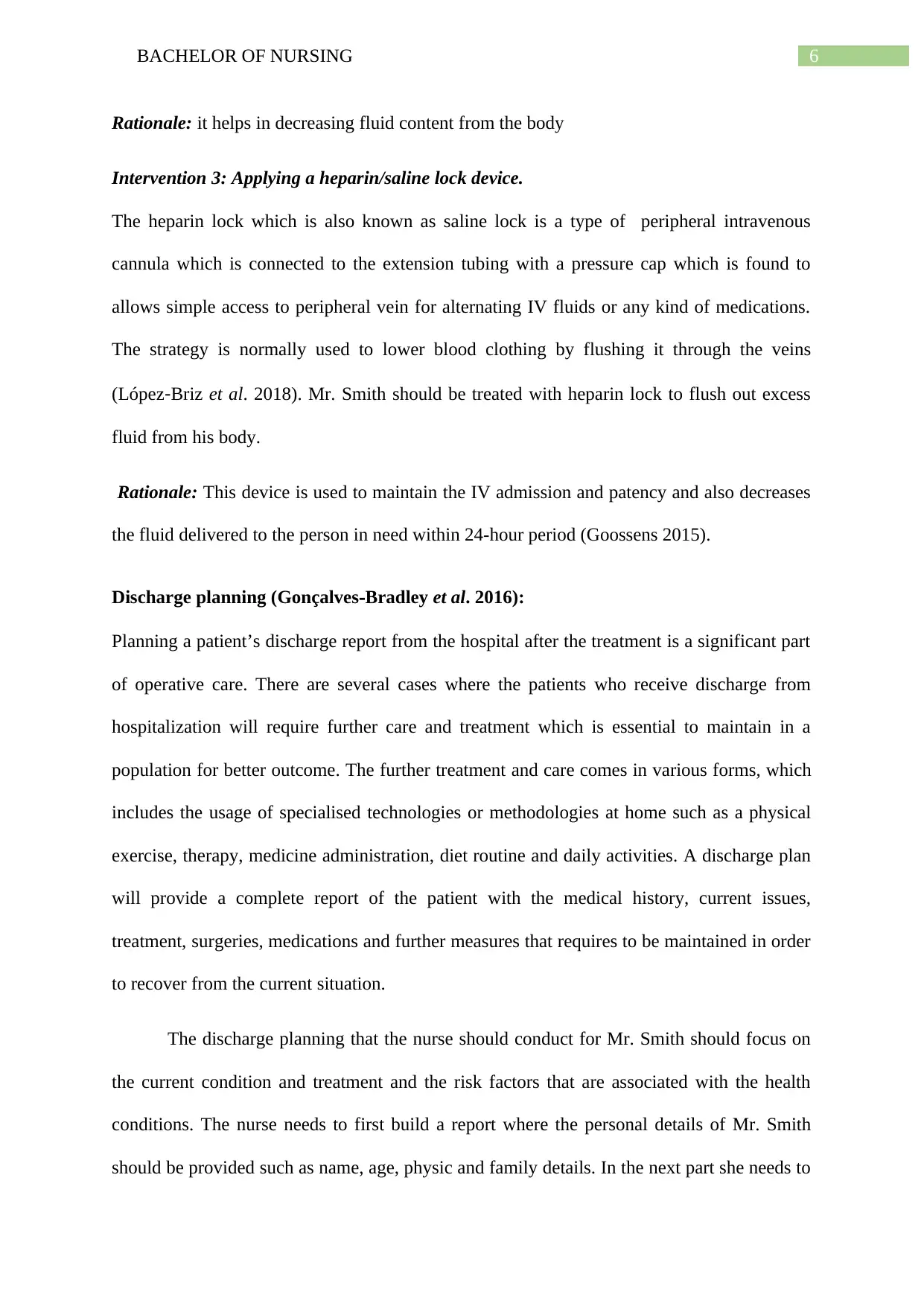
6BACHELOR OF NURSING
Rationale: it helps in decreasing fluid content from the body
Intervention 3: Applying a heparin/saline lock device.
The heparin lock which is also known as saline lock is a type of peripheral intravenous
cannula which is connected to the extension tubing with a pressure cap which is found to
allows simple access to peripheral vein for alternating IV fluids or any kind of medications.
The strategy is normally used to lower blood clothing by flushing it through the veins
(López‐Briz et al. 2018). Mr. Smith should be treated with heparin lock to flush out excess
fluid from his body.
Rationale: This device is used to maintain the IV admission and patency and also decreases
the fluid delivered to the person in need within 24-hour period (Goossens 2015).
Discharge planning (Gonçalves‐Bradley et al. 2016):
Planning a patient’s discharge report from the hospital after the treatment is a significant part
of operative care. There are several cases where the patients who receive discharge from
hospitalization will require further care and treatment which is essential to maintain in a
population for better outcome. The further treatment and care comes in various forms, which
includes the usage of specialised technologies or methodologies at home such as a physical
exercise, therapy, medicine administration, diet routine and daily activities. A discharge plan
will provide a complete report of the patient with the medical history, current issues,
treatment, surgeries, medications and further measures that requires to be maintained in order
to recover from the current situation.
The discharge planning that the nurse should conduct for Mr. Smith should focus on
the current condition and treatment and the risk factors that are associated with the health
conditions. The nurse needs to first build a report where the personal details of Mr. Smith
should be provided such as name, age, physic and family details. In the next part she needs to
Rationale: it helps in decreasing fluid content from the body
Intervention 3: Applying a heparin/saline lock device.
The heparin lock which is also known as saline lock is a type of peripheral intravenous
cannula which is connected to the extension tubing with a pressure cap which is found to
allows simple access to peripheral vein for alternating IV fluids or any kind of medications.
The strategy is normally used to lower blood clothing by flushing it through the veins
(López‐Briz et al. 2018). Mr. Smith should be treated with heparin lock to flush out excess
fluid from his body.
Rationale: This device is used to maintain the IV admission and patency and also decreases
the fluid delivered to the person in need within 24-hour period (Goossens 2015).
Discharge planning (Gonçalves‐Bradley et al. 2016):
Planning a patient’s discharge report from the hospital after the treatment is a significant part
of operative care. There are several cases where the patients who receive discharge from
hospitalization will require further care and treatment which is essential to maintain in a
population for better outcome. The further treatment and care comes in various forms, which
includes the usage of specialised technologies or methodologies at home such as a physical
exercise, therapy, medicine administration, diet routine and daily activities. A discharge plan
will provide a complete report of the patient with the medical history, current issues,
treatment, surgeries, medications and further measures that requires to be maintained in order
to recover from the current situation.
The discharge planning that the nurse should conduct for Mr. Smith should focus on
the current condition and treatment and the risk factors that are associated with the health
conditions. The nurse needs to first build a report where the personal details of Mr. Smith
should be provided such as name, age, physic and family details. In the next part she needs to
Paraphrase This Document
Need a fresh take? Get an instant paraphrase of this document with our AI Paraphraser

7BACHELOR OF NURSING
write down all the medical conditions from the past and present state. The treatment and
medications that he has been provided with should be mentioned with proper details such as
techniques and treatments that where applied and the reason behind them, medications with
their specific admiration route and the issue for which they are provided.A proper chart of the
diet that Mr. Smith should maintain must be mentioned in the discharge plan and the things
he must not perform after he is discharge to go home. The proper details about the routine
check-up duration should be mentioned to the report. The discharge plan should be prepared
with proper consultancy with the other healthcare facilities including the surgeons and the
general physician that were involved in the care process (Rodakowski et al. 2017).
Conclusion:
In order to conclude it can be stated by following the ABCDE frame work of nursing
ca help in assessing a condition or a patient case study to figure out the problem and proper
treatment for the patient’s better outcome. The interventions that the nurses would implicate
for the conditions of impaired gas exchange and excess lung fluid may help Mr. Smith in
getting better from his health condition and also reduce the risk factors associated with the
disease and the treatment process. A proper discharge plan will guide him and his family to
provide proper healthy living and treatment in home and it will also help him to understand
the proper administration routine of the particular medication.
write down all the medical conditions from the past and present state. The treatment and
medications that he has been provided with should be mentioned with proper details such as
techniques and treatments that where applied and the reason behind them, medications with
their specific admiration route and the issue for which they are provided.A proper chart of the
diet that Mr. Smith should maintain must be mentioned in the discharge plan and the things
he must not perform after he is discharge to go home. The proper details about the routine
check-up duration should be mentioned to the report. The discharge plan should be prepared
with proper consultancy with the other healthcare facilities including the surgeons and the
general physician that were involved in the care process (Rodakowski et al. 2017).
Conclusion:
In order to conclude it can be stated by following the ABCDE frame work of nursing
ca help in assessing a condition or a patient case study to figure out the problem and proper
treatment for the patient’s better outcome. The interventions that the nurses would implicate
for the conditions of impaired gas exchange and excess lung fluid may help Mr. Smith in
getting better from his health condition and also reduce the risk factors associated with the
disease and the treatment process. A proper discharge plan will guide him and his family to
provide proper healthy living and treatment in home and it will also help him to understand
the proper administration routine of the particular medication.
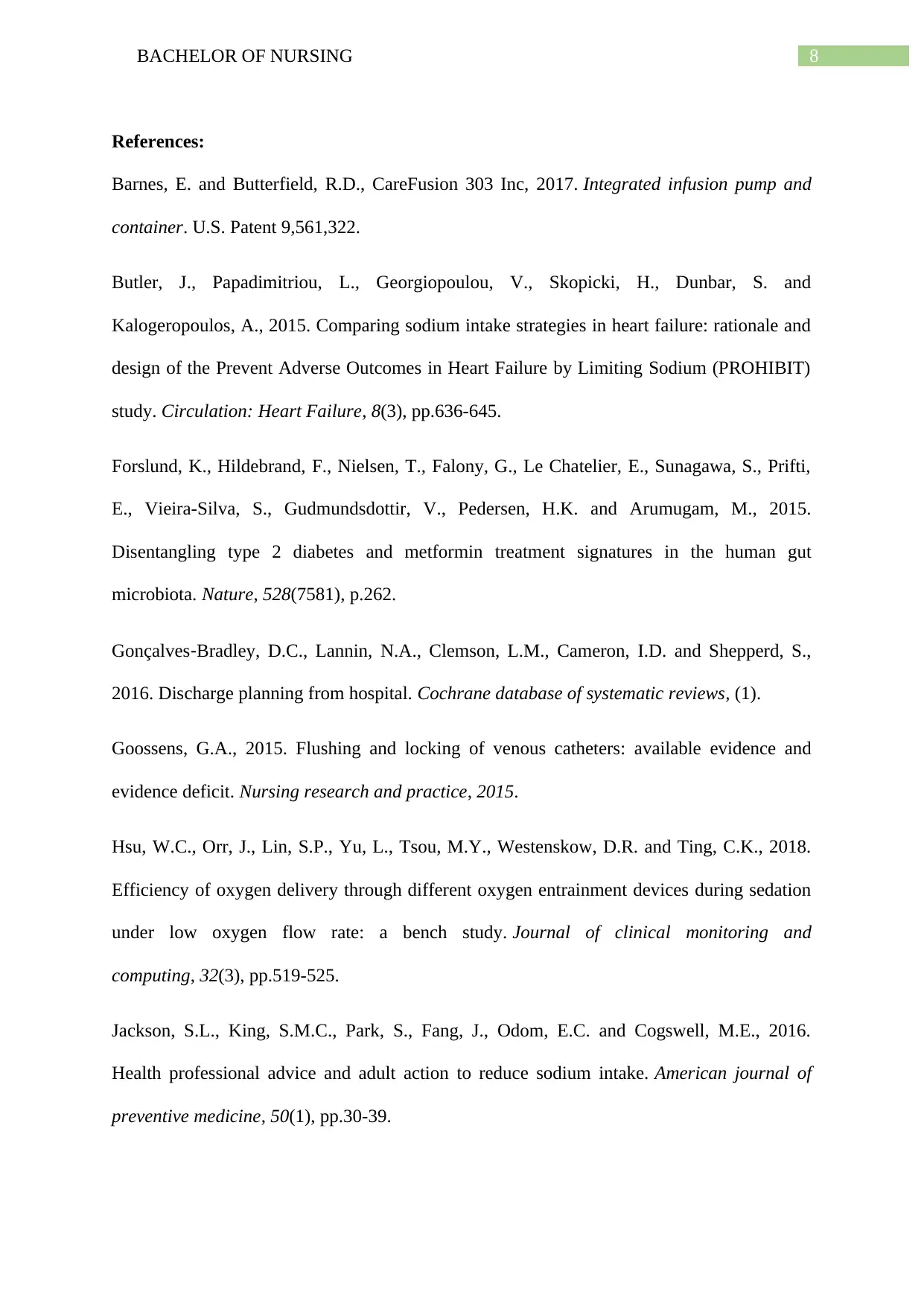
8BACHELOR OF NURSING
References:
Barnes, E. and Butterfield, R.D., CareFusion 303 Inc, 2017. Integrated infusion pump and
container. U.S. Patent 9,561,322.
Butler, J., Papadimitriou, L., Georgiopoulou, V., Skopicki, H., Dunbar, S. and
Kalogeropoulos, A., 2015. Comparing sodium intake strategies in heart failure: rationale and
design of the Prevent Adverse Outcomes in Heart Failure by Limiting Sodium (PROHIBIT)
study. Circulation: Heart Failure, 8(3), pp.636-645.
Forslund, K., Hildebrand, F., Nielsen, T., Falony, G., Le Chatelier, E., Sunagawa, S., Prifti,
E., Vieira-Silva, S., Gudmundsdottir, V., Pedersen, H.K. and Arumugam, M., 2015.
Disentangling type 2 diabetes and metformin treatment signatures in the human gut
microbiota. Nature, 528(7581), p.262.
Gonçalves‐Bradley, D.C., Lannin, N.A., Clemson, L.M., Cameron, I.D. and Shepperd, S.,
2016. Discharge planning from hospital. Cochrane database of systematic reviews, (1).
Goossens, G.A., 2015. Flushing and locking of venous catheters: available evidence and
evidence deficit. Nursing research and practice, 2015.
Hsu, W.C., Orr, J., Lin, S.P., Yu, L., Tsou, M.Y., Westenskow, D.R. and Ting, C.K., 2018.
Efficiency of oxygen delivery through different oxygen entrainment devices during sedation
under low oxygen flow rate: a bench study. Journal of clinical monitoring and
computing, 32(3), pp.519-525.
Jackson, S.L., King, S.M.C., Park, S., Fang, J., Odom, E.C. and Cogswell, M.E., 2016.
Health professional advice and adult action to reduce sodium intake. American journal of
preventive medicine, 50(1), pp.30-39.
References:
Barnes, E. and Butterfield, R.D., CareFusion 303 Inc, 2017. Integrated infusion pump and
container. U.S. Patent 9,561,322.
Butler, J., Papadimitriou, L., Georgiopoulou, V., Skopicki, H., Dunbar, S. and
Kalogeropoulos, A., 2015. Comparing sodium intake strategies in heart failure: rationale and
design of the Prevent Adverse Outcomes in Heart Failure by Limiting Sodium (PROHIBIT)
study. Circulation: Heart Failure, 8(3), pp.636-645.
Forslund, K., Hildebrand, F., Nielsen, T., Falony, G., Le Chatelier, E., Sunagawa, S., Prifti,
E., Vieira-Silva, S., Gudmundsdottir, V., Pedersen, H.K. and Arumugam, M., 2015.
Disentangling type 2 diabetes and metformin treatment signatures in the human gut
microbiota. Nature, 528(7581), p.262.
Gonçalves‐Bradley, D.C., Lannin, N.A., Clemson, L.M., Cameron, I.D. and Shepperd, S.,
2016. Discharge planning from hospital. Cochrane database of systematic reviews, (1).
Goossens, G.A., 2015. Flushing and locking of venous catheters: available evidence and
evidence deficit. Nursing research and practice, 2015.
Hsu, W.C., Orr, J., Lin, S.P., Yu, L., Tsou, M.Y., Westenskow, D.R. and Ting, C.K., 2018.
Efficiency of oxygen delivery through different oxygen entrainment devices during sedation
under low oxygen flow rate: a bench study. Journal of clinical monitoring and
computing, 32(3), pp.519-525.
Jackson, S.L., King, S.M.C., Park, S., Fang, J., Odom, E.C. and Cogswell, M.E., 2016.
Health professional advice and adult action to reduce sodium intake. American journal of
preventive medicine, 50(1), pp.30-39.
⊘ This is a preview!⊘
Do you want full access?
Subscribe today to unlock all pages.

Trusted by 1+ million students worldwide
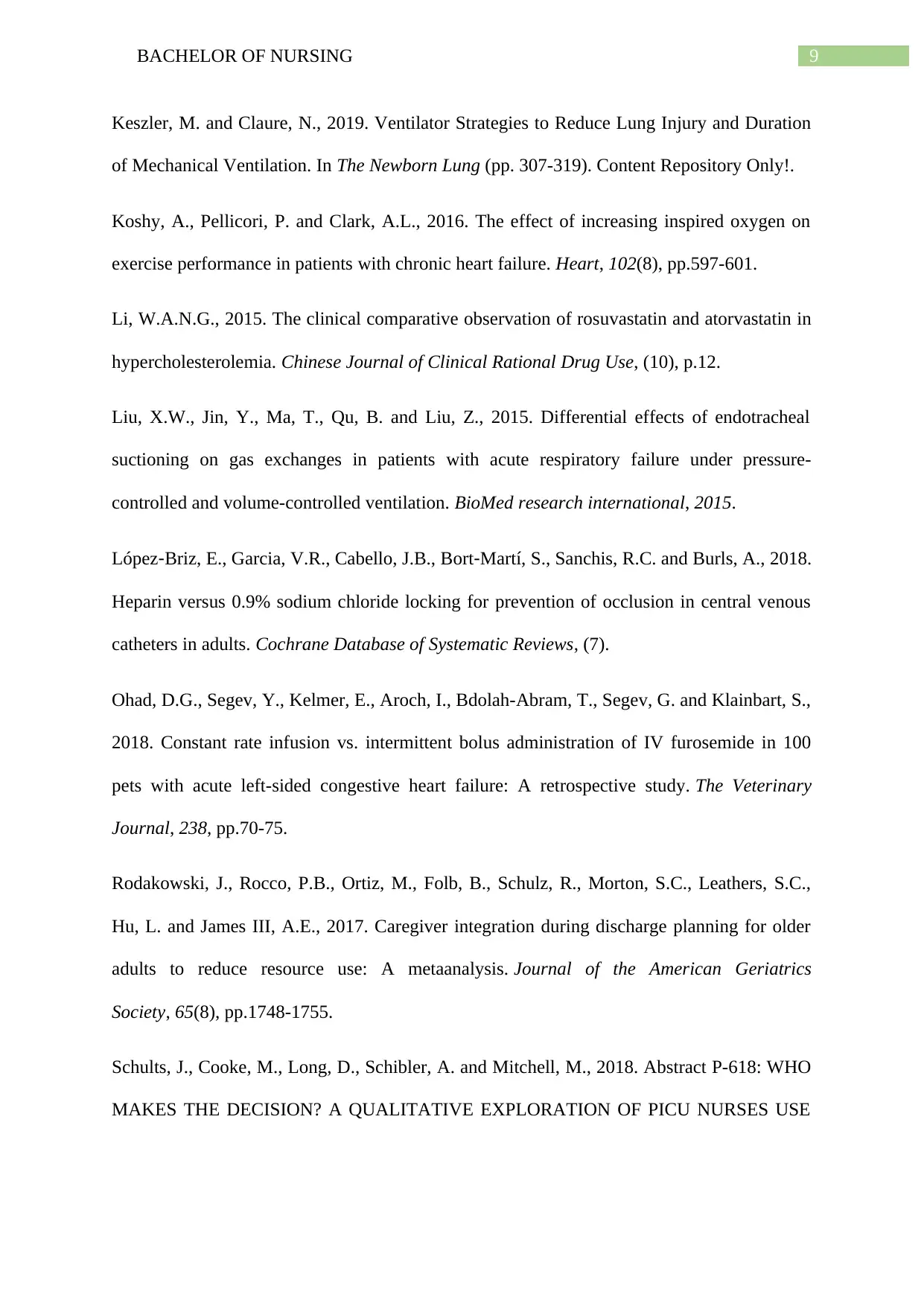
9BACHELOR OF NURSING
Keszler, M. and Claure, N., 2019. Ventilator Strategies to Reduce Lung Injury and Duration
of Mechanical Ventilation. In The Newborn Lung (pp. 307-319). Content Repository Only!.
Koshy, A., Pellicori, P. and Clark, A.L., 2016. The effect of increasing inspired oxygen on
exercise performance in patients with chronic heart failure. Heart, 102(8), pp.597-601.
Li, W.A.N.G., 2015. The clinical comparative observation of rosuvastatin and atorvastatin in
hypercholesterolemia. Chinese Journal of Clinical Rational Drug Use, (10), p.12.
Liu, X.W., Jin, Y., Ma, T., Qu, B. and Liu, Z., 2015. Differential effects of endotracheal
suctioning on gas exchanges in patients with acute respiratory failure under pressure-
controlled and volume-controlled ventilation. BioMed research international, 2015.
López‐Briz, E., Garcia, V.R., Cabello, J.B., Bort‐Martí, S., Sanchis, R.C. and Burls, A., 2018.
Heparin versus 0.9% sodium chloride locking for prevention of occlusion in central venous
catheters in adults. Cochrane Database of Systematic Reviews, (7).
Ohad, D.G., Segev, Y., Kelmer, E., Aroch, I., Bdolah-Abram, T., Segev, G. and Klainbart, S.,
2018. Constant rate infusion vs. intermittent bolus administration of IV furosemide in 100
pets with acute left-sided congestive heart failure: A retrospective study. The Veterinary
Journal, 238, pp.70-75.
Rodakowski, J., Rocco, P.B., Ortiz, M., Folb, B., Schulz, R., Morton, S.C., Leathers, S.C.,
Hu, L. and James III, A.E., 2017. Caregiver integration during discharge planning for older
adults to reduce resource use: A metaanalysis. Journal of the American Geriatrics
Society, 65(8), pp.1748-1755.
Schults, J., Cooke, M., Long, D., Schibler, A. and Mitchell, M., 2018. Abstract P-618: WHO
MAKES THE DECISION? A QUALITATIVE EXPLORATION OF PICU NURSES USE
Keszler, M. and Claure, N., 2019. Ventilator Strategies to Reduce Lung Injury and Duration
of Mechanical Ventilation. In The Newborn Lung (pp. 307-319). Content Repository Only!.
Koshy, A., Pellicori, P. and Clark, A.L., 2016. The effect of increasing inspired oxygen on
exercise performance in patients with chronic heart failure. Heart, 102(8), pp.597-601.
Li, W.A.N.G., 2015. The clinical comparative observation of rosuvastatin and atorvastatin in
hypercholesterolemia. Chinese Journal of Clinical Rational Drug Use, (10), p.12.
Liu, X.W., Jin, Y., Ma, T., Qu, B. and Liu, Z., 2015. Differential effects of endotracheal
suctioning on gas exchanges in patients with acute respiratory failure under pressure-
controlled and volume-controlled ventilation. BioMed research international, 2015.
López‐Briz, E., Garcia, V.R., Cabello, J.B., Bort‐Martí, S., Sanchis, R.C. and Burls, A., 2018.
Heparin versus 0.9% sodium chloride locking for prevention of occlusion in central venous
catheters in adults. Cochrane Database of Systematic Reviews, (7).
Ohad, D.G., Segev, Y., Kelmer, E., Aroch, I., Bdolah-Abram, T., Segev, G. and Klainbart, S.,
2018. Constant rate infusion vs. intermittent bolus administration of IV furosemide in 100
pets with acute left-sided congestive heart failure: A retrospective study. The Veterinary
Journal, 238, pp.70-75.
Rodakowski, J., Rocco, P.B., Ortiz, M., Folb, B., Schulz, R., Morton, S.C., Leathers, S.C.,
Hu, L. and James III, A.E., 2017. Caregiver integration during discharge planning for older
adults to reduce resource use: A metaanalysis. Journal of the American Geriatrics
Society, 65(8), pp.1748-1755.
Schults, J., Cooke, M., Long, D., Schibler, A. and Mitchell, M., 2018. Abstract P-618: WHO
MAKES THE DECISION? A QUALITATIVE EXPLORATION OF PICU NURSES USE
Paraphrase This Document
Need a fresh take? Get an instant paraphrase of this document with our AI Paraphraser
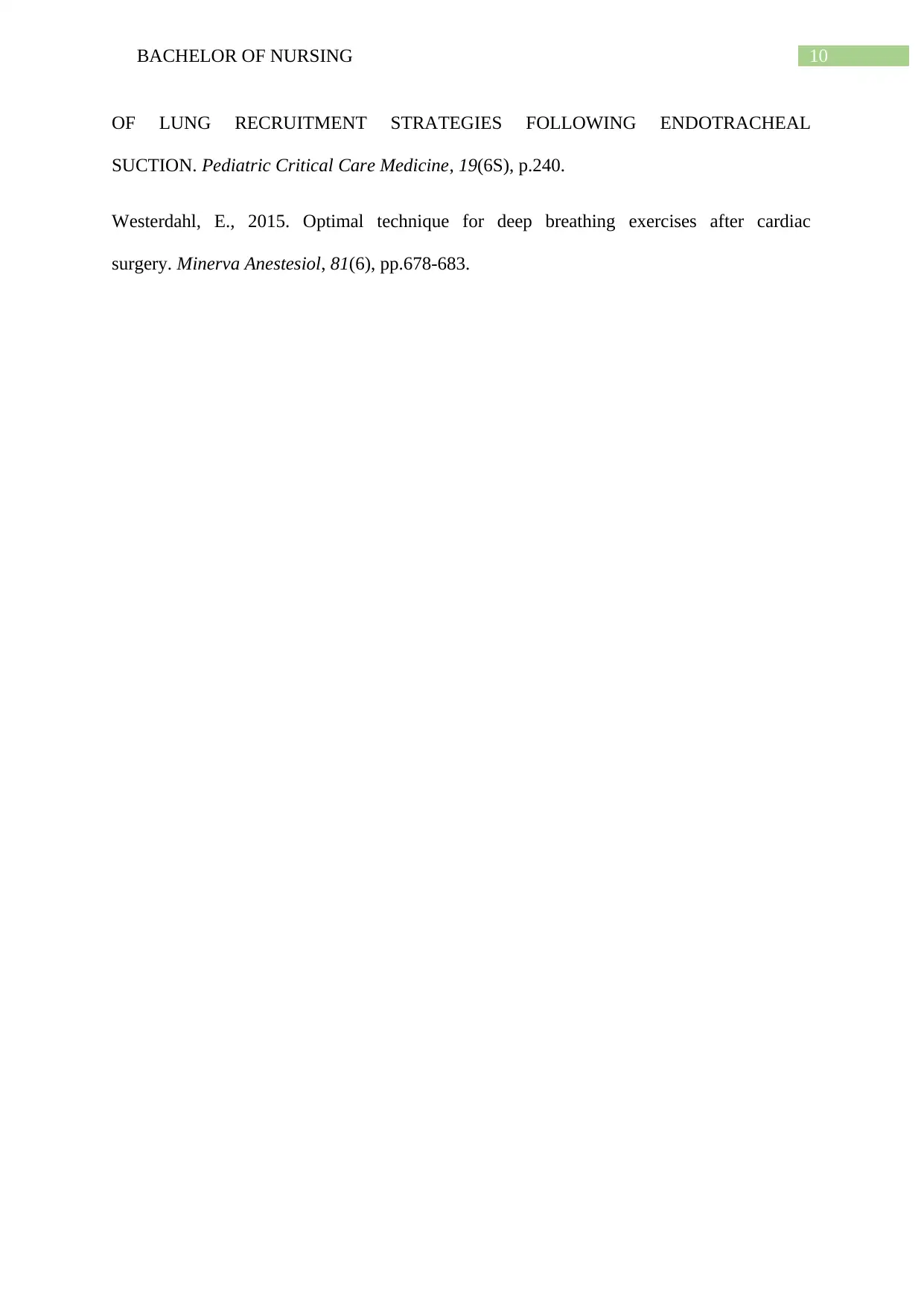
10BACHELOR OF NURSING
OF LUNG RECRUITMENT STRATEGIES FOLLOWING ENDOTRACHEAL
SUCTION. Pediatric Critical Care Medicine, 19(6S), p.240.
Westerdahl, E., 2015. Optimal technique for deep breathing exercises after cardiac
surgery. Minerva Anestesiol, 81(6), pp.678-683.
OF LUNG RECRUITMENT STRATEGIES FOLLOWING ENDOTRACHEAL
SUCTION. Pediatric Critical Care Medicine, 19(6S), p.240.
Westerdahl, E., 2015. Optimal technique for deep breathing exercises after cardiac
surgery. Minerva Anestesiol, 81(6), pp.678-683.
1 out of 11
Related Documents
Your All-in-One AI-Powered Toolkit for Academic Success.
+13062052269
info@desklib.com
Available 24*7 on WhatsApp / Email
![[object Object]](/_next/static/media/star-bottom.7253800d.svg)
Unlock your academic potential
Copyright © 2020–2025 A2Z Services. All Rights Reserved. Developed and managed by ZUCOL.





